| Srl | Item |
| 1 |
ID:
100334
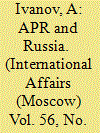

|
|
|
|
|
| Publication |
2010.
|
| Summary/Abstract |
TEN YEARS AGO when the Asian countries were extricating themselves from the 1997 Asian financial crisis few expected the vast Asian-Pacific Region (APR) to become the locomotive of global development of the 21st century. The locomotive, meanwhile, remained as efficient as ever at the peaks of the current world financial and economic crisis. Indonesia (the GDP of which increased by 4.5% in 2009 and is moving toward 6% in 2010) is rapidly catching up with China and India, the new leaders of economic advance in the APR. According to Merrill Lynch in 2009 the total private assets of the APR countries increased by 31% (the world's highest) to reach $9.7 trillion; in the same year the number of dollar millionaires in Asia increased by 26% to come even with the European figure of 3 million (North America is home to 3.1 million). The Boston Consulting Group forecasted that in 2010 the level of wealth in the APR will go up twice as fast as the world's average; this explains a broader and more active involvement of banking giants Barclays, Morgan Stanley and UBS in Asia.
The economic upsurge of the APR is highly important for Russia which is the region's inalienable and fairly large part. When dealing with Russia's application to the Asia-Europe Meeting (ASEM) and the need to include it in either the Asian or European part the Meeting was confronted with the dilemma which had kept the Slavophiles and Westerners busy for a long time. Resolved by famous Russian poet Alexander Blok who called Russians "leafs of the Asian tree" the issue acquired an international political-economic dimension in the globalization era.
|
|
|
|
|
|
|
|
|
|
|
|
|
|
|
|
| 2 |
ID:
116049
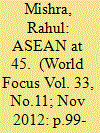

|
|
|
| 3 |
ID:
108532
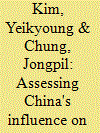

|
|
|
|
|
| Publication |
2011.
|
| Summary/Abstract |
It is widely known that China's influence on Southeast Asia has been growing
rapidly since the Asian financial crisis of 1997. However, determining the true
dimensions of China's influence in this region is still controversial. It seems quite
conspicuous that the growing economic relations between China and the region
give China more bargaining power, due to the expanding role of the bilateral trade
and China's foreign aid in promoting the regional economic growth. However,
this does not give us a clear picture of how China has been able to exercise its
influence on the behavior of the states in the region for its own interests. Therefore,
this paper tries to assess China's influence on Southeast Asia by analyzing the
specific case of Taiwan. Recently, China's rising influence has significantly
affected Southeast Asia's relations with Taiwan. Southeast Asian states are paying
more attention to the cross-Strait relations when considering attempting to improve
relations with Taiwan. This research defines "influence" as the capability of state
A to affect the behavior of state B, either directly or indirectly, to comply with state
A's policy interests. If the diplomatic behavior of state B changes accordingly
due to the action, then it can be said that state A has illustrated its influence over
state B. By studying the Taiwan issue, this paper reveals that China has been
quite successful in exercising its influence on Southeast Asian states to comply
with China's policy toward Taiwan.
|
|
|
|
|
|
|
|
|
|
|
|
|
|
|
|
| 4 |
ID:
112144


|
|
|
|
|
| Publication |
2012.
|
| Summary/Abstract |
This paper discusses the political opportunity structures which facilitated the creation of sites of interaction and protest against the Asian Development Bank during the Bank's Annual General Meeting in Chiang Mai, Thailand, in 2000. The factors which facilitated the coming together of Thai social movements and their regional and international counterparts are mainly their shared critique of the neo-liberal paradigm and its adverse effects on their respective countries. The strategies they used to highlight these effects enhanced their sites of engagement and confrontation with the Bank and included dialogue with Bank officials, demonstrations, and the use of the media to highlight their concerns. Importance was also placed on the manner in which they were able to mobilize resources for the anti-Asian Development Bank campaigns and the process by which they framed their issues to gain the sympathy and support of the public. The 1997 Asian financial crisis, which highlighted the shortcomings of the Bank's development paradigm, as well as the ongoing democratization process in Thailand during that period, provided the impetus in fostering the anti-globalization alliances of local and transnational social movements in a common venue.
|
|
|
|
|
|
|
|
|
|
|
|
|
|
|
|
| 5 |
ID:
121582
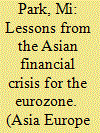

|
|
|
|
|
| Publication |
2013.
|
| Summary/Abstract |
This paper comparatively examines diverse responses from three major actors in the global political economy (the state, civil society, international financial institutions) to the Asian financial crisis of 1997 and the current eurozone crisis. First, it analyses conditional lending policies of international financial institutions (IFIs) such as the International Monetary Fund toward countries in fiscal distress. It then critically examines how the lending policies engendered social tensions and conflicts as austerity measures such as cuts to social welfare programmes hit hard on the populace. Examining how the state and civil society in Asia reacted to and, as a result of contentious state-civil society interactions, altered the policies of IFIs, the paper draws lessons from the Asian financial crisis for the European Union and puts forwards alternative policy suggestions.
|
|
|
|
|
|
|
|
|
|
|
|
|
|
|
|
| 6 |
ID:
120530
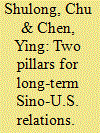

|
|
|
|
|
| Publication |
2013.
|
| Summary/Abstract |
Sino-U.S. relationship has been supported by two pillars: one being their shared interests and points in common, and the other being that neither side has challenged, threatened or opposed each other's core interests. The two powers should continue to strengthen these two pillars in order to maintain stable and positive relations.
|
|
|
|
|
|
|
|
|
|
|
|
|
|
|
|